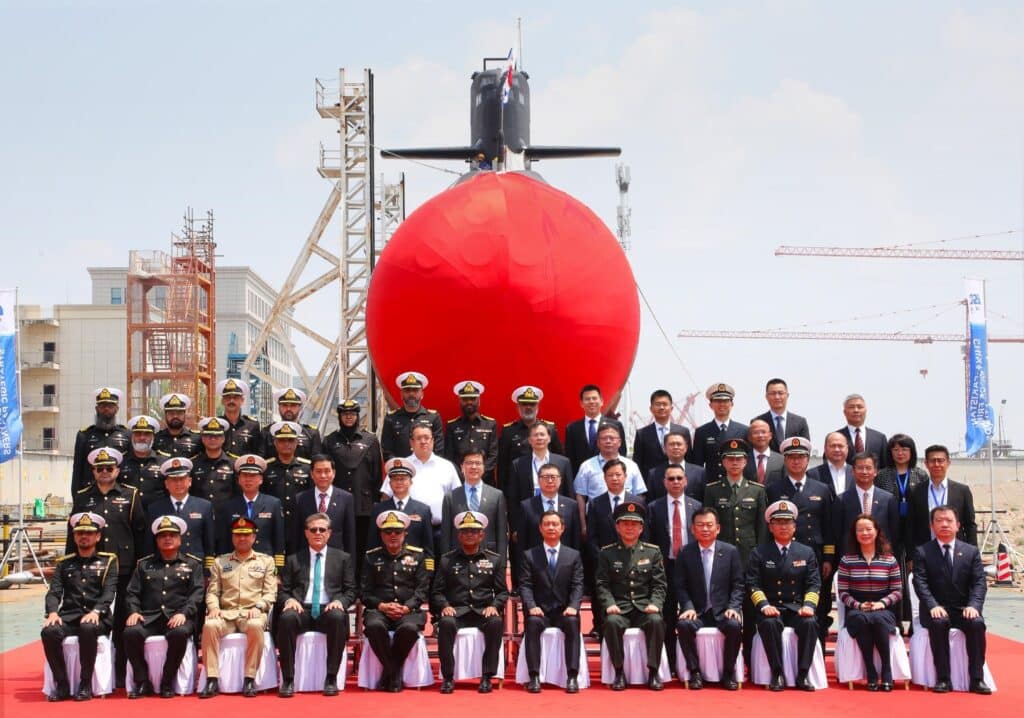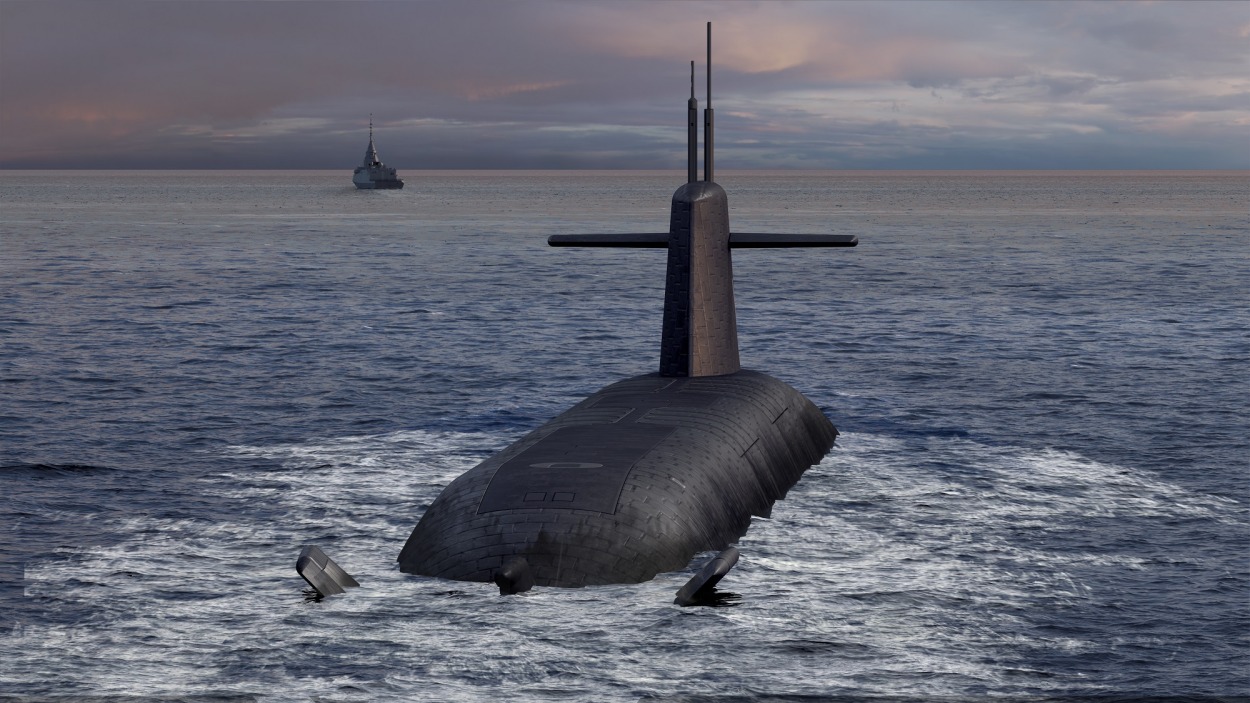Pakistan has taken a significant leap forward in bolstering its naval capabilities with the recent launch of the first Hangor-class submarine, marking a milestone in its strategic partnership with China.
The acquisition of this advanced vessel, the first of eight slated for acquisition, is set to boost the Islamic Republic’s military might in the Indian Ocean and Arabian Sea.
The launch ceremony, held on April 26 at the Wuchang Shipbuilding yard in Wuhan, China, was graced by high-ranking officials from both Pakistan and China. Among the attendees were representatives from Wuchang Shipbuilding Industry Group Company Ltd and China Shipbuilding & Offshore International Company Ltd.
Adm. Naveed Ashraf, Pakistan’s naval chief, expressed his satisfaction with the project’s progress, emphasizing the pivotal role these submarines equipped with state-of-the-art weapons and sensors would play in maintaining peace and stability in the region.
He underscored the significance of the Pak-China friendship, stating that the Hangor-class submarines would add a new dimension to this enduring partnership, which has been increasingly vital in countering regional challenges, particularly those posed by India.
Launching ceremony of 1st #PN #HANGOR Class Submarine held at Shuangliu Base Wuhan,China. #CNS Adm Naveed Ashraf graced occasion as CG. CG emphasized importance of maritime security under prevailing geo strategic environment &PN resolve to ensure regional peace &stability. (1/2) pic.twitter.com/X2CgsUFUpb
— DGPR (Navy) (@dgprPaknavy) April 26, 2024
The Hangor-class submarines, an export variant of the People’s Liberation Army-Navy’s (PLA-N) Type 039B Yuan-class submarines, are a product of the agreement signed during President Xi Jinping’s visit to Islamabad in April 2015.
Under this agreement, Pakistan contracted China for eight submarines, four of which were to be built in China and the remaining four to be constructed by Karachi Shipyard & Engineering Works Ltd (KS&EW) under Transfer of Technology (ToT).
While details about the submarines’ subsystems and specific weapon systems remain undisclosed by the Pakistan Navy, it is reported that these vessels could potentially be equipped with submarine-launched cruise missiles (SLCM), thus providing Pakistan with a significant deep strike capability.
The Hangor-class submarines exhibit significantly enhanced underwater endurance. They can remain submerged for extended periods ranging from 10 to 14 days.
This capability far exceeds the typical 48-hour endurance of conventional diesel-powered vessels. Concerning their dimensions, these submarines are anticipated to measure 76 meters in length and boast a displacement of 2,800 tons.
This makes them marginally shorter in length yet heavier than the original S26 submarine, designed initially as an export variant of the Type 039B primarily designated for Thailand.
Equipped With Chinese Engines?
The Hangor-class submarines, touted for their modern design and advanced subsystems, were initially intended to be equipped with German MTU 396 diesel engines. However, Germany’s refusal to grant export licenses for these engines has left the power source for the boats in question.
The lack of confirmation from Germany or Pakistan regarding the approval or denial of export clearance further adds to the issue’s ambiguity.
Naval expert Alex Luck weighed in, expressing confidence that Chinese diesel engines might power these submarines instead of the originally intended German MTU units.
Luck added, “It makes little sense to deny Thailand the engines and approve them for Pakistan. Granted, the deal for Pakistan I think pre-dates the Thai deal by several years and may notionally fall into an era where Berlin was more lenient. But given the silence around it, I suspect above.”
The German government previously refused export licenses for its engines concerning Thailand’s order of the S-26T, a Chinese Type 039B submarine variant.

Consequently, the once-promising Thai deal collapsed, and Thailand officially announced in October 2023 its decision to abandon the purchase due to the unavailability of German engines.
In 2017, the initial contract to buy the S26T Yuan-class submarine with German-origin MTU-396 diesel engines was framed. However, Germany’s withdrawal from the agreement, citing policy restrictions on using its engines, triggered complications.
Beijing suggested a domestically manufactured substitute to rescue the agreement, providing reverse-engineered CHD620 engines from China’s state-owned submarine manufacturer. The CHD620 engine is a Chinese-produced version of the German MTU396 engine, manufactured under license.
The Chinese offer triggered intense negotiations between the Thai and Chinese military officials. However, Thailand ultimately rejected the Chinese-made engine, allegedly expressing apprehensions about its quality.
Speaking to EuAsian Times, Sheikh Akhter, an Indian Air Force veteran and a Warfare & Defense Systems expert, said, “The Hangor Class incorporates sophisticated noise reduction methods such as anechoic tiles, passive/active noise reduction, and an asymmetrical seven-blade skewed propeller. It is anticipated that the 039A will achieve a quietness comparable to other contemporary diesel-electric submarines, making them challenging to detect.”
However, he added, “Speculation has circulated regarding the presence of German technology in Chinese warships. Due to the absence of a formal decision regarding the EU arms embargo on China in alignment with European treaties, certain exports of engines may potentially be permitted for the Chinese navy.”
Concerns For India?
The Hangor-class submarines represent a leap forward for Pakistan’s naval prowess. Incorporating Air-independent propulsion (AIP) technology in these Chinese submarines also gives Pakistan a crucial advantage, as none of India’s submarines currently boast this capability.
Akhter pointed out, “The Hangor class features an air-independent propulsion system created by the 711th Research Institute of the China Shipbuilding Heavy Industry Group Corp.”
Akhter further explained, “The design characteristics of the Hangor class submarine suggest its suitability for operations in deep waters near coastal areas, particularly in regions like the approaches to Taiwan. Enhanced sonar and air-independent propulsion (AIP) capabilities enable the submarine to detect, track, and engage targets of interest in these areas effectively.”
“Although there are plans to equip the Hangor Class with a more potent, long-range anti-ship cruise missile (ASCM) in the near future, the submarine’s design constraints will still heavily depend on its torpedo systems,” he added.

This technological edge underscores Pakistan’s strategic intent to assert itself in the maritime domain, especially vis-à-vis its regional rival, India.
Akhter noted, “The Hangor-class submarines, equipped with advanced features like air-independent propulsion (AIP) and cutting-edge sensors, hold a significant edge over India’s top Kalvari class submarines.”
India currently possesses 16 operational submarines, comprising five Kalvari-class (French Scorpene), four Shishumar-class (German Type-209), and seven Sindhugosh-class (Russian Kilo) submarines. Furthermore, the imminent commissioning of another Kalvari-class submarine will augment the naval fleet to 17 submarines.
However, many of these submarines are over two decades old and nearing their decommissioning date. On the other hand, the delayed implementation of submarine acquisition projects, such as Projects 75 and 75I, has further exacerbated India’s maritime vulnerabilities.
Should the P-75-I program fail to deliver submarines by the close of this decade, India’s submarine fleet will dwindle to six Scorpenes. This reduction will occur due to the decommissioning of both the Russian Kilo and four German Type-209 submarines.
Moreover, despite India’s capabilities in designing and constructing SSBNs (ballistic missile submarines) with high indigenous content, it struggles to independently develop conventional submarines, necessitating collaboration with international partners.

Nonetheless, Pakistan’s acquisition of the Hangor-class submarines is expected to mark the beginning of a widening gap in submarine capabilities between New Delhi and Islamabad.
The inclusion of the eight Hangor-class submarines will raise Pakistan’s total count of AIP-equipped submarines to 11. Islamabad had previously incorporated a French AIP system into three of its Agosta 90B submarines in 2008.
By empowering Pakistan’s maritime forces, China aims to counterbalance India’s growing influence in the Indian Ocean region. The Hangor-class submarines serve as a tangible manifestation of China’s strategic investments in Pakistan, aimed at challenging India’s regional hegemony.
Akhter suggested. “The unveiling of Pakistan’s new stealth submarine is perceived as a strategic move by Beijing to exert pressure on India. This development will compel India to enhance its naval capabilities in response.”
“India should consider retrofitting the AIP system into its current vessels or incorporating it into a new submarine class. However, this transition is estimated to take another seven to ten years before India achieves AIP submarine capabilities,” according to the Akhter.
- Contact the author at ashishmichel(at)gmail.com
- Follow EurAsian Times on Google News




